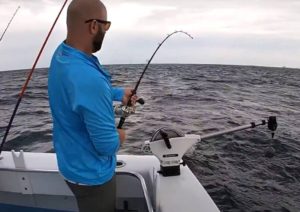
Image source: Sam Carlson
Setting up a fishing pole for saltwater fishing is one of the most significant challenges you face as a new angler. All those gizmos, knots, tools, and whatever else is in the heap of things inside your tackle box are insanely confusing.
The good news is that learning how to set up a fishing line for saltwater is difficult. Once you understand what rigging is, what the parts do, and the different types of configurations, it is much less stressful.
Let’s get started so you can get to fishing.
Saltwater Rigging Basics
Rigging is the section of line and equipment that connects to your fishing line. It includes:
- A connector or knot — swivels, connectors, or you can use specific knots to connect line to line.
- Hooks or lures — You may use hooks and bait hooks and lures or hooks and jigs.
- Weights — otherwise known as sinkers, splitshot, lead triangles, are what sinks your line in the water column.
- Line — Mono or monofilament, fluorocarbon, or braided are common types of fishing lines. Some of these overlap in what they do and how we use them, but you often choose your line based on the fish targets.
Tip: You can make rigging ahead of time and keep it in your tackle box. Setup individual rigging and place one set in its own zip bag. You can set them up with the hooks on for specific applications or leave the hook off to add more versatility to the rigging. Setting up fishing line rigging ahead of time saves you a lot of time and work when you are on the water.
NOTE: A saltwater fishing rig, and there are many, changes depending on where you fish, what you target, and the type of weather. For example, on a high wind day, you probably will add more weight. On the other hand, if you are fishing in shallow water, you might place the weight above or below the hook depending on where you want the hook to be.
Before fishing, always check the local fishing regulation
Different Types of Saltwater Rigs
For the sake of simplicity, as this topic could quickly become a book, we will focus on four types of saltwater rigs. Those include:
- Surf Fishing — one or two, sometimes three hooks, a weight, and a connector. The goal is to create a situation where the hook and bait or lure dances in the water stream as the wave actions ebbs and wanes. You can set the rigging with the weight above the hooks or below.
- Fishing with Lures — A Carolina Rig is often the rig we use when fishing with a lure or a jig.
- Bottom Fishing — Often a two-hook rig with a sinker on the bottom.
- Pier Fishing — Often a Carolina Rig or a Float Rig, depending on what you target.
When and where you fish and the water conditions and depths often dictate what kind of rig you choose. Below we give you a four-step plan for creating the perfect saltwater fishing line rig.
Learn more about the different environments for fishing.
4 Steps To A Perfect Saltwater Fishing Pole Setup
The Caroline Rig is one of the most versatile saltwater setups, and it is so easy to learn.
What you will need:
- An off-set hook – size depending on what you target.
- A Bullet weight
- A Bead
- A Swivel
Step 1: Slide the sinker or bullet weight onto the fishing line, followed by the bead. The bead and the sinker act together to create a bit of resonance in the water. Fish have a lateral line that allows them to feel vibrations in the water. When the sinker slides down and touches the bead, it creates a resonance that fish can feel. The lateral line on a fish is one of the ways they find food. The bead, and it can be a plastic bead or glass bead, keeps your knot from being damaged by the edge of the sinker. With a Carolina setup, the sinker is free to slide up and down the line.
Step 2: Slide the end of the line through the swivel. A half hitch or improved clinch knot is good.
NOTE: so far, you are working with just the end of the line from the reel. In step three, we add a leader line.
Step 3: Cut a piece of line that is 15-24 inches long. You use a shorter leader when the water is calmer and a longer leader when the water has more movement to it. If you are fishing inshore over weedy patches, a short leader is probably best. If you are fishing in deeper water, then a longer leader is best. Adjust the length of the leader to fit the fishing situation. Leaders can be a yard long, though generally, they are shorter than two feet.
Tie the leader to the swivel.
Step 4: Tie the hook, lure, or jig to the end of the leader. An improved clinch knot is good, though you can check out our article all about saltwater knots too.
All that is left to do is bait the hook if you use bait and drop the line. A little TIP: if you are spot casting, a shorter leader is more accurate.
Read more about common fishing rigs.
